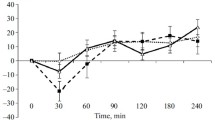Summary
-
1.
Tolerance to morphine-induced analgesia (hot plate and acetic acid whrithing test), hypothermia and lethality can be quantified in mice by measuring the degree of parallel shifts of semilog. dose-response relationships induced by repeated opioid administration.
-
2.
A similar procedure can be used for the quantification of naloxone-induced withdrawal as an indicator of dependence.
-
3.
The intensity of tolerance development with respect to time of administration and dosage of morphine varies with the test procedure. It is closely parallel, however, in both analgesic tests during acquisition of tolerance.
-
4.
Log-log-linear relationships exist between tolerance in analgesic tests and physical dependence as determined by naloxone-induced withdrawal.
-
5.
The minimum tolerance-inducing dose of morphine in different tests could not be correlated to the ED50's in these tests.
-
6.
Chronic opiate treatment leads to a decrease or an increase in motility response to morphine, depending on the time that has elapsed after the last morphine administration.
Similar content being viewed by others
References
Campbell, R. C.: Statistische Methoden für Biologie und Medizin, p. 41. Stuttgart: Thieme 1971
Cavalli-Sforza, L.: Biometrie Grundzüge biolog.-medizin. Statistik, pp. 171–173. Stuttgart: G. Fischer 1969
Cheney, A. L., Goldstein, A.: Tolerance to opioid narcotics: Time course and reversibility of physical dependence in mice. Nature (Lond.) 232, 477–478 (1971)
Cicero, T. J., Meyer, E. R.: Morphine pellet implantation in rats: Quantitative assessment of tolerance and dependence. J. Pharmacol. exp. Ther. 184, 404–408 (1973)
Collier, H. O. J.: Tolerance, physical dependence and receptors: A theory of the genesis of tolerance and physical dependence through drug-induced changes in the number of receptors. Advanc. Drug Res. 3, 171–188 (1966)
Dingledine, R., Goldstein, A.: Lethality of the morphinan isomers Levorphanol and Dextrorphan. Brit. J. Pharmacol. 48, 718–720 (1973)
Eddy, N. B., Leimbach, D.: Synthetic analgesics. II. Dithenylbutanol and dithenylbutylamines. J. Pharmacol. exp. Ther. 107, 385–393 (1953)
Goldstein, A., Goldstein, D. B.: Enzyme expansion theory of drug tolerance and dependence. The addictive states. Ass. Res. nerv. Dis. Proc. 46, 265 (1968)
Himmelsbach, C. K.: Clinical studies of drug addiction, physical dependence, withdrawal and recovery. Arch. intern. Med. 69, 766–772 (1942)
Himmelsbach, C. K.: With reference to physical dependence. Fed. Proc. 2, 201 (1943)
Huidobro, F.: Some relations between tolerance and physical dependence to morphine in mice. Europ. J. Pharmacol. 15, 79–84 (1971)
Jaffe, J. H.: Drug addiction and drug abuse. The pharmacological basis of therapeutics (C. S. Goodman and A. Gilman, eds.), pp. 276–313. Toronto: MacMillan Co. Ltd. 1969
Jaffe, J. H., Sharpless, S. H.: Pharmacological denervation super-sensitivity in the central nervous system: A theory of physical dependence. The addictive states. Ass. Res. nerv. Dis. Proc. 46, 226–246 (1968)
Kalant, H., Le Blanc, A. E., Gibbins, R. J.: Tolerance to and dependence on some non opiate psychotropic drugs. Pharmacol. Rev. 23, 135–191 (1971)
Maggiolo, C., Huidobro, F.: Acta physiol. lat.-amer. 11, 70–78 (1961). Cited by L. Shuster: In: Narcotic drugs. (D. H. Clouet, ed.), p. 413. New York-London: Plenum Press 1971
Martin, W. R.: A homeostatic and redundancy theory of tolerance and dependence on narcotic analgesics. The addictive states. Ass. Rev. nerv. Dis. Proc. 46, 206–225 (1968)
Rethy, C. R., Smith, C. B., Villareal, J. E.: Effects of narcotic analgesics upon the locomotor activity and brain catecholamine content of the mouse. J. Pharmacol. exp. Ther. 176, 472–479 (1970)
Richter, J. A., Goldstein, A.: Tolerance to opioid narcotics. II. Cellular tolerance to levorphanol in mouse brain. Proc. nat. Acad. Sci. (Wash.) 66, 944–951 (1970)
Shuster, L.: Repression and de-repression of enzyme synthesis as a possible explanation of some aspects of drug action. Nature (Lond.) 189, 314 (1961)
Shuster, L.: Tolerance and physical dependence. In: Narcotic drugs (D. H. Clouet, ed.), pp. 408–423. New York: Plenum Press 1971
Takemori, D. E., Oka, T., Nishiyama, N.: Alteration of analgesic receptor-antagonist interaction induced by morphine. J. Pharmacol. exp. Ther. 186, 261–265 (1973)
Theiss, P., Herz, A., Bläsig, J.: Vergleich der Entwicklung der Morphinabhängigkeit und Morphintoleranz bei der Ratte. Arzneimittel-Forsch. (Drug Res.) 24, 1014 (1974)
Way, E. L., Loh, H. H., Shen, F. H.: Simultaneous quantitative assessment of morphine tolerance and physical dependence. J. Pharmacol. exp. Ther. 167, 1–8 (1969)
Author information
Authors and Affiliations
Rights and permissions
About this article
Cite this article
Fernandes, M., Kluwe, S. & Coper, H. Quantitative assessment of tolerance to and dependence on morphine in mice. Naunyn-Schmiedeberg's Arch. Pharmacol. 297, 53–60 (1977). https://doi.org/10.1007/BF00508810
Received:
Accepted:
Issue Date:
DOI: https://doi.org/10.1007/BF00508810




